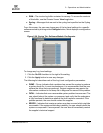
2 – Operations and Administration
Configuration and Monitoring Features
2-18 D000003-006 Rev. A
Q
❥ ALARM - Indicates that a serious problem has occurred which degrades
capacity or service. If the error is recoverable, the user should correct the
failure. If the alarm/failure persists, the user should reboot the system at a
convenient time. If the problem is still not cleared, the user should contact the
supplier.
❥ WARNING - Indicates that a recoverable problem has occurred. The user
does not need to take action.
❥ PARTIAL - When more information is available, Partial causes additional
message-related details to be displayed.
❥ CONFIGURATION: An informational message indicating changes that a user
has made to the system configuration. The user does not need to take any
action.
❥ INFO: Informational messages that occur during a system or component boot.
The user does not need to take any action.
❥ PERIODIC: An informational message containing periodic statistics. The user
does not need to take action.
Debug message levels 1 through 5: Debug messages are for supplier and/or
SilverStorm engineering use and are not necessarily indicative of actions that
an end user may need to take.
❥ DEBUG1 – Messages that describe the states of connections and links.
❥ DEBUG2 – Messages that describe major configuration changes or
operations.
❥ DEBUG3 – Messages that describe the I/O flow.
❥ DEBUG4 – Messages that contain the packet dumps within an I/O flow. I/O
flows contain multiple packets.
❥ DEBUG5 – Messages that contain the packet dumps within an I/O flow. I/O
flows contain multiple packets.
Important: When configuring the log levels to display debug messages, care should
be taken to ensure that system performance issues are weighed against
troubleshooting requirements. Generally, the higher the debug number the more
information is written to the log. Specifically, debug 3-5 have the most affect on
system performance.


















